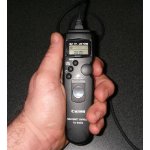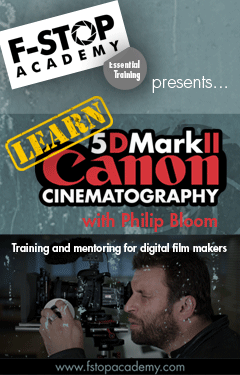As most regular readers know I adore time lapse. I love what the EX1 and EX3 are capable of but have never gotten around to using the function on the Canon 5dmkII despite seeing the amazing results Tom @ Timescapes has done.
This was done as part of my shooting video with the Canon 7d DVD that we filmed in Florida the past few days. I talk about timelapse in one of the chapters. This timelapse was taken at Lido key near Sarasota.
All you need is the camera, a nice fully charged battery, lots of space on your CF card and this remote (click on image for more info)
I simply set the shutter on the camera to stay open for 2 seconds. Had the ISO set to 100, stopped down the Sigma 10mm f2.8 down to get exposure. Plugged in the intervolmeter, set it to take 1 picture every 2 seconds and left it running for about 20 minutes. By leaving the shutter open to 2 seconds I got nice streaky image.
This remote works for both the 5dmkII and the 7d.
I then imported the image sequence using quicktime image sequence, selected the first image in the folder, set the frame rate for the sequence which I set for 30p as that I was the DVD was shot at and it simply created a HUGE resolution timelapse. I scaled it down to full HD for here and you can download it direct from vimeo.
More details on how easy it is to do and much much more on the upcoming 7d video training DVD. Click on full screen button to go full screen or as i said download full hd version from vimeo.
So with the 7d you can do lovely slow motion and great timelapse. A truly versatile camera.
Timelapse test with the Canon 7d from Philip Bloom on Vimeo.
Anyone who buys the 5dmkII DVD will have exclusive access to additional web 7D content going over the differences in the cameras and what you need to know to make the most out of them.
Want to see amazing timelapse from the 5dmkII? Check out Tom @ timescapes latest. He is the master!
Timescapes Timelapse: Mountain Light from Tom @ Timescapes on Vimeo.
www.twitter.com/timescapes
I’m working on a big 9-minute follow-up to “Learning to Fly”, but it won’t be ready till next summer. Meantime, here are some shots from my trip in August to California’s White Mountains and Yosemite, all shot on the Canon 5D2.
These are sequences from my first film – “These Short Days” – currently in production. If anyone happens to know a good producer or production company who might be willing to help shepherd this film to completion next Fall, I would really appreciate an introduction. Much thanks!
To contact me: http://www.timescapes.org/contact.html
(Music is Michael Stearns. My sincerest and most humble admiration to Ron Fricke and Mark Magidson.)
Some behind-the-scenes vids showing how I did several of these shots:
Full 1080p direct download link is available from Vimeo in the lower-right-hand corner of this page, if you are logged in to Vimeo.



35 comments
Groovy. Maybe I’ll buy the 7D tutorial after all.
Does that intervalometer have a limit on the number of actuations? I have a cheapo one for my 40d which is great, save for the fact it’s limited to 399 shots. Some examples of its use here:
http://vimeo.com/4518216
looks great!
are u still in Florida Mr. Bloom?
Could you have done HDR (High Dynamic Range) pictures?
Also, you left your shutter at 360° ? Doesn’t the 180° rule still apply for timelapses?
Thanks for your numerous articles, great to read!
the 180 rule doesn’t apply to timelapse as I was using very slow shutter to accumulate the light to give the streaks.
thanks for your answer
@Euan – Pretty sure there are no limits, for another alternative you can check out PClix – https://www.pclix.com/shopping/shopexd.asp?id=1 I have one of these and like it a lot. It is a bit cheaper than the TC-80, although I understand you can find TC-80s pretty cheap on Ebay. I know the Pclix will keep firing until its batteries where out.
I also use an automator script to resize my images before pulling them into quicktime. You can get that script from here – http://digital-photography-school.com/how-i-made-a-time-lapse-movie-with-my-dslr as well as see the really cool Eclectic 2.0 timelapse.
I use my 5D2 for timelapse but really any DSLR can produce them, at least resolution wise. The things the 5d2 and 7d bring to the table are better ISO performance, that is about it (compared to other DSLRs that is)
FYI Nikons have intervalometers built in.
Great example Philip, thanks for sharing, and I agree with Myles.
Quick question about the remote though. Can the remote start and stop video? Just wondering. Thanks in advance and keep pushing us all to greater heights.
Simple and great workflow Mr Bloom, I have almost the same one with my old Rebel XT time lapses.
If you want to save space, you can shoot in medium size jpg 2496 x 1664 (I don’t know if the 5D and 7D have this options, the Rebel is not a pro camera) You still have to scale it down to be full HD but it’s the closest size to it.
I think it’s more fun and creative to shoot with a DSLR these days.
If you don’t want to pay $130 for the cable release, you can use the Canon EOS Utility software that came with your camera. Simply tether it to your computer.
Its convenient because it saves them directly on your computer and you can open the timelapse in Quicktime 7 as an Image Sequence even when it is still taking pictures.
When it finally finishes the timelapse, simple save it out of Quicktime and you have your movie in a few seconds.
It’s not great for remote locations and long shoots, but if you just want to try a timelapse for free, plug in your camera to your computer.
Hi Phillip, great video.
Like most, I have questions about the Timer Remote…
Is it possible to use it to fire the shutter immediately, like an old shutter release cable?
Is it possible to start/stop video too?
Slightly unrelated, but is it possible to take a still during the recording of video? It would be great to get production stills of through the actual video lens…!
Many thanks.
Matt.
yes you can fire shutter immediately. There are some real in depth reviews of this remote online if you look for them as it is capable of many things.
No you cannot use it for video
When you take a photo whilst recording video the video recording pauses and it takes a photo, video recording then resumes
Hi Philip,
Did you shoot RAW files or jpeg? If RAW did Quicktime read them OK or did you need to process them into jpegs first?
Hi mate,
I shot Raw to give me more options but of course nothing can recognize them yet. Aperture and Lightroom say no! So had to convert to JPEG with the 7d software from Canon.
I swear that camera is permanently attached to you. Do you sleep or shoot 24/7 🙂
sleep?
Hi Philip,
Thanks for your tutorials. I recently purchased a Canon 7D and did my own time-lapse test and gave a hat-tip to you. Cheers:
http://www.absolutepresence.com/2009/11/timelapse/
Hi, someone told me that time lapse with DSLR could reduce a lot the equipment life since it has a limit of shots. What do you think about it? Thanks a lot.
Yes and no… Yes in the sense that for a 5 minutes piece (which might have taken all night to complete) at 24 or 30 frames per second, you are shooting 24 or 30 frames/sec * 60 seconds * 5 mins = 7200 or 9000 actuations on your camera. And even if you have a good camera like a 50D/ 7D/ MKII the life expectancy is 100k/150K/300K respectively (I think).
ND
Hi, just a question:
is the remot intervalometer suitable also for new canon eos 55OD?
if not, what else you suggest for time-lapse video making?
thanksomuch
L
check out my blog on first thoughts of that cam. link there
I love the first time lapse video with the 7D. Do you use still images, grouped together, to create all of your time lapse, or do you use the actual camcorder functionality also?
Russell,
time lapse on the 7D, (5DmII, etc…) is achieved by creating an “image sequence” in “QuickTime”, (or other appropriate app.), by “stringing” still images together, and selecting a frames per second speed for playback.
I understand some cameras can of course produce time lapse while shooting in a “video mode” of operation. But, it is my understanding that, (I use a 7D), with Canon’s EOS DSLR line of cameras, time lapse can only be executed in a stills mode.
On the workflow side, I like to shoot raw for maximum flexibility, then I bring it all into Capture One Pro. Once imported, I’ll pick a keyframe, set it’s color balance and exposure/contrast to my liking, apply an HD format crop to it and then copy it’s settings across the group. Then what’s nice is I can setup a process recipe that outputs the images at 1920×1080 (72dpi). I dig having everything formatted and ready to go for FCP.
Cheers,
C
Hi Philip,
I was one of the lucky ones who attended your fantastic one day DSLR class in Boston in July. Now I’m a very happy Canon 7D owner.
Quick question: What’s the best way to avoid time lapse flicker? No matter what I do, I always run into this problem. What’s the best fix for this? Do you cover this anywhere on your web site?
Thanks again for all the knowledge you share with us.
Cheers,
– Nicholas
check out my red tails timelapse blog. I mention a plug in i use there. Best p
Are you tight to a cable with this thing?
Can you used it to remote start/ stop the video recording also???
you need a remote timer and no it’s for stills only
i was wondering what resolution you shoot your time laps specially if you want to add it in a regular movie filmed for example with a 5d mark2?
thanks for the help and keep the good work. 🙂
small is ok, but i tend to like the extra rez of large jpeg
Hi all, I’ve been having fun with my 7D and was keen to get an intervalometer for TL which also had the ability to start/stop video, when using it as a standard cable remote. My camera bag is filling up quickly, so I’m keen to know if a exists with both of these features. Thanks for being so active in the community Philip, you’re a real inspiration.
I read above that there is possibly a way to do timelapse without the controller? Is that correct? I am just curious as I am a film student and Im trying to save as much money as possible on my production.
What lens was used for the Sarasota Time lapse clip?
Says right in the post that it was the Sigma 10mm f2.8 ;).